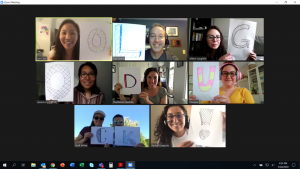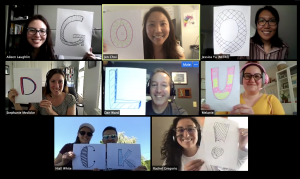
Hey Superhero, What’s Your Theme Song?
*Free reader tip: Read this article with headphones on, listening to something catchy. That’s how this article was written after all…*
Every decent superhero has a theme song. Some go “NA NA NA NA NA NA NA NA BATMAN!” while others are more like “Call me, beep me if you wanna reach me.” To each their own, right?
As you are most certainly a superhero yourself (why else would you be reading this?), you may wonder why said musical melodies don’t sing your name when you face sudden peril, risk ridicule, or tantalize a triumphant victory as you open a kitchen drawer with your left hand while drying a dish with your right and close the dishwasher with your toes (#kitchensuperherostatusunlocked). Well, in this article’s whimsical world, let’s just assume that smooth backup vocals, brassy trumpet sections, and impromptu dance offs are a regular daily occurrence in your life.
Since you’re a superhero, you and your team also have a brand. It may be strong and intentional, or perhaps less strong and less unintentional. Said brand is more than the logo on your business card, or the letter painted on your caped blue and red spandex onesie. It’s at the core of why you your team, project, or service exists in a given context.
What does your brand look like? Are you innovative? Helpful? Dependable? Open-minded? Socially conscious? Are you growth oriented? Perhaps you have a brand you want to change. Doesn’t matter. First and foremost, you need to be aware of what your brand is. How you figure this out is a different topic for a different day. THIS DAY, however, is about that song that plays when you enter a room. It’s the key to your brand!
Let’s take a look at three techniques to establish your brand/theme song: 1) Moving the needle, 2) Rewind, and 3) Anti-Shock. First, we must set the stage.
Setting the stage
You enter the conference room, nervous about your presentation (Yes, in person…if you can remember what that felt like…). Chatting dies down and you’re introduced. Faces stare. You begin your presentation on _________(fill in the blank. “Single track trail vegetation after wildfire and regrowth???”). People seem to disengage. Energy suffers. The camera stops on your face. Your head voice starts to sing softly (like, the voice inside your head, not your head voice when trying to reach a higher pitch). Your eyes narrow into a heroic squint as lyrics fill your head, energy rising. You slam your laptop closed, slide into a stagger stance, point to the audience, and sing a powerful, head bobbing, foot stomping of a question to the first person that catches your gaze.
The room goes silent. The person stares back; timidly looks around the room. As the music begins to swell, with a rush of confidence, the person replies with a soulful wail, words expressing that they were in fact paying attention to your presentation, and only appeared passive, as they had a late-night doing housework.
You nod and tap your foot as the music backs them up. Two more join in, and soon you’re pointing to slides, kick-ball-changing to get your point across, maybe even a little jazz-hands from time to time. Choruses break out, and soon everyone is spinning their chairs in sync.
What comes next? you guessed it: You’re having a tap dance off with Terry (you didn’t know she tap danced…). Dang she’s good. Never before had such a presentation taken place in the history of conference room presentations. You call out a question and the chorus responds. You air guitar a few slide bullets and are greeted with a slew of opinionated dance styles. Suddenly, Barrie walks in the room, late, as is his brand. Everyone stops. The room stands still. A few papers float to the floor. Next thing you know, Barrie is electric sliding his way into the room and yes, a musical life dream is fulfilled. Time to pick your next technique.
1) Moving the Needle
When I was a kid, my dad had a really nice record player that we’d, on rare occasion, pull out (‘twas the era of CDs and Laserdisks. Yes, we had not one, but two Laserdisk players…which was awesome). Record needles were hard to find at that time, so we had to learn to delicately move the needle to select the songs.
I remember us playing the LP version of Kansas, Leftoverture’s “Carry on My Wayward Son” on one input, while playing the CD version on another. We’d switch inputs back and forth, determining which sounded better. May be memory bias, but I seem to remember the vinyl having more presence, warmth, and life. After all, that record had surely been played a lot, and probably had its fair share of scratches from the needle. These imperfections are what made it so special!
Establishing your brand can be a delicate process. It might take time, multiple tries, and perhaps even scratching the record a time or two. This is ok! Your team, company, product, or service likely has a diverse set of experiences, talents, and ambitions. You don’t have to get it right the first time. You may think you’ve landed on what defines your identity, and realize you were not only wrong, but on Side A when you should definitely be on Side B (tracking what I’m saying?? Pun intended. You’re welcome).
Don’t be afraid to change! Experiment! At the personal level, if your brand is based off of a lifetime of habits and behaviors, it’s ok to change! You may find that you’re a lot happier playing the deep track than you are the greatest hit that everyone knows. The deep track might have the best musicianship on the album. Do what resonates with you. At the end of the day, you’ll be happier spending your time on something that excites you. You’ll also likely bring more positive change to others by sharing your passionate energy.
Rewind
Hold on, back up, what was that? I remember listening to Blues Traveler’s “Four” album. After enjoying a dose of Runaround, I discovered the 90’s blues rock, adrenaline inducing, Playing 4s example of Crash Burn. Part way through the song, John Popper breaks off in a harmonic (like, with his harmonica..) solo, followed by a competitive riptide guitar riff, followed by bass and then drums (hence, Playing 4s). My mind was blown! Rewind! Listen. Rewind! Listen. You get the picture.
If you find something that works for your brand, study it! Repeat it! Ask yourself why it works, why it energizes you, why it brings your team together, why it makes your customers adore you for your niche offering. Odds are it is a big contributor to your brand.
Anti-Shock
It might be fair to say that a large part of today’s workforce has no idea what I mean by Anti-Shock. This was a symbol of audial status in days gone by! I’m pretty sure my portable Panasonic CD player had 90 seconds of Anti-Shock. I could mow the lawn, bouncing hip pack and all, and make it through album after album without any skips or screeches emanating from my (corded) headphones. Those without anti-shock weren’t so lucky…
Similarly, your brand will exist in a challenging environment, full of bumps and skips. You may experience a brand identity crisis! A competitor offers similar services. An executive takes the company in a new direction. A key team player leaves for a new opportunity (necessitating a key change? OK OK I’ll stop…).
This or something similar IS going to happen. You may be forced to rethink your mission, vision, purpose. Your strategy might not make sense anymore. This being said, the foundational parts of your brand identity can remain strong and immovable through preparatory “Anti-Shock”. Have you empowered your team with a shared leadership model? Have you learned to celebrate failure? Have you baked in a key ingredient: Fun? These tools will provide “Anti-Shock when your brand is challenged. You may still experience jolts or skips, but your audience, the listener, may not even notice as your theme song continues to play.
Listen, Kronk got it right in The Emperor’s New Groove. He may not have called it his “brand”, but he understood the need for a theme song. Be intentional. Drink your “Gummi Berri Juice”. Write the notes down. Experiment. Scribble out what doesn’t work and write something new. Move the needle. Rewind. Establish foundational, immovable aspects of your brand identity that can withstand the shocks of change.
“All the world’s waiting for you, and the power you possess.” When you enter the room, throw your hands in the air and look boldly at those before you, for your theme song begins.





